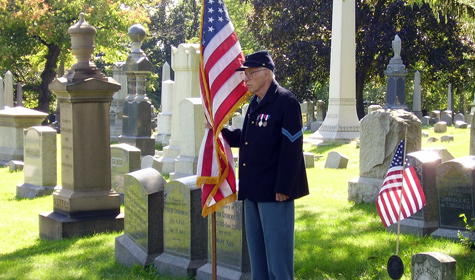By Lennin Reyes
The Bronx Journal
People like Patricia De Cicco of Brooklyn and Bernie Schwarz of New Hyde Park on Long Island travel far to satisfy their craving for the history of the Civil War. They trekked to Woodlawn Cemetery in the Bronx September 18th to take a tour of Civil War plots. Organized by the Friends of Woodlawn, the tour visited the graves of nine people known for their work during the Civil War, whether as soldiers, civilians or diplomats. This tour was held to commemorate the 150th anniversary of the start of the Civil War. New York is one of the few states that has no Civil War commission.
The first grave visited was that of Lt. Edward Knox, who entered the military at a questionable age, either 17 or 19. This was because he was tall for his age and he drew a mustache on himself to join the military. After fighting in Gettysburg with the 8th Volunteer company, he followed in the footsteps of his father by selling beaver hats.
The next grave was that of civilian William Earle Dodge. He was part of the Union League Club, who opposed President Abraham Lincoln’s war policies at the time. His group also improved conditions at Rikers Island for troops who wanted to train for battle.
Next up was Elizabeth Cady Stanton. Known for being part of the women’s suffrage movement during the 19th Century, she also played a part in the anti-slavery movement by allying with ex-slave Sojourner Truth. This was inspired partly because her father was a slave owner. Stanton would hold the Seneca Falls Convention in 1848. It was at this stop where Sojourner Truth’s hymn, which follows the melody of the popular New Year’s Day Anthem, “Auld Lang Syne,” was sung by members of the tour.
Next up was Major Theodore Greig. He was part of the 61st New York Volunteers, who fought in the Battle of Antietam in 1863. On Sunken Road, Greig would capture the Confederate Flag despite being shot by the Southerners. He would win the Medal of Honor due to this action. After this battle, President Lincoln would speak a rough draft of the Emancipation Proclamation.
The next grave was one of a local Bronx resident, Captain Oliver J. Tilden. A native of Morrisania, which was part of Westchester County in the mid-19th Century, this painter and carpenter left his family to fight the Civil War. At this stop, members of a Civil War organization spoke about Tilden and his legacy.
Next up was Richard Busteed, a member of the Brigade of General United States Volunteers during the Civil War. He was also a Methodist preacher who favored Stephen Douglas in the 1860 election (due to his opposition to Lincoln at the time). As time passed, however, Douglas decided to switch his alliance to the Union, which angered his previous Republican allies. It was this swap which cost him a chance to be Alabama District Judge. However, he ended up winning the post after the Civil War due to having equal enemies
Next up was David Farragut. The son of a Revolutionary War fighter, he was born as James Farragut. However, after the death of David Porter, one of Porter’s sons decided to rename him to David Farragut. At the age of 12, Farragut joined that son in battle. During the Civil War period, Farragut decided to move from his native Tennessee to Hastings-on-Hudson, New York, where he was met with opposition. However, he would capture the ports of New Orleans and Mobile Bay by way of ramming through the forts. He would become the first ever rear admiral, eventually becoming admiral before his death in 1870.
Next was Archibald Gracie III. Born in Mobile to a cotton exporting family, Gracie would graduate out of the West Point Academy and become a Confederate general for the 11th Alabama Regimen. He would move to Elizabeth, New Jersey, where he was met with a tar and feather suit from the locals. Gracie would end up dying due to an artillery bomb blowing up near him. His grandfather, Archibald Gracie, would build Gracie Mansion in Manhattan, currently the residence of the mayor of New York City.
The last grave was that of Herman Melville. A rebel youth, he would write a series of poems known as “Battle Pieces, Aspects of the Civil War” in 1866. He would be famous for another story he wrote, “Moby Dick.”
In regards to the tour, Patricia De Cicco of Brooklyn commented, “I like traveling this far to learn about the history of the Civil War as well as those who took part of it, whether fighting or doing something else.” As for Bernie Schwarz of New Hyde Park, “I was interested in David Farragut since he fought for over 50 years of his life,” he said.
A special thanks to Brian Sahd and the Friends of Woodlawn Cemetery for holding this event, as well as many others in Woodlawn Cemetery. Another special thanks goes out to Peter Bunten, for providing the knowledge of the Civil War and for giving out the tour.



